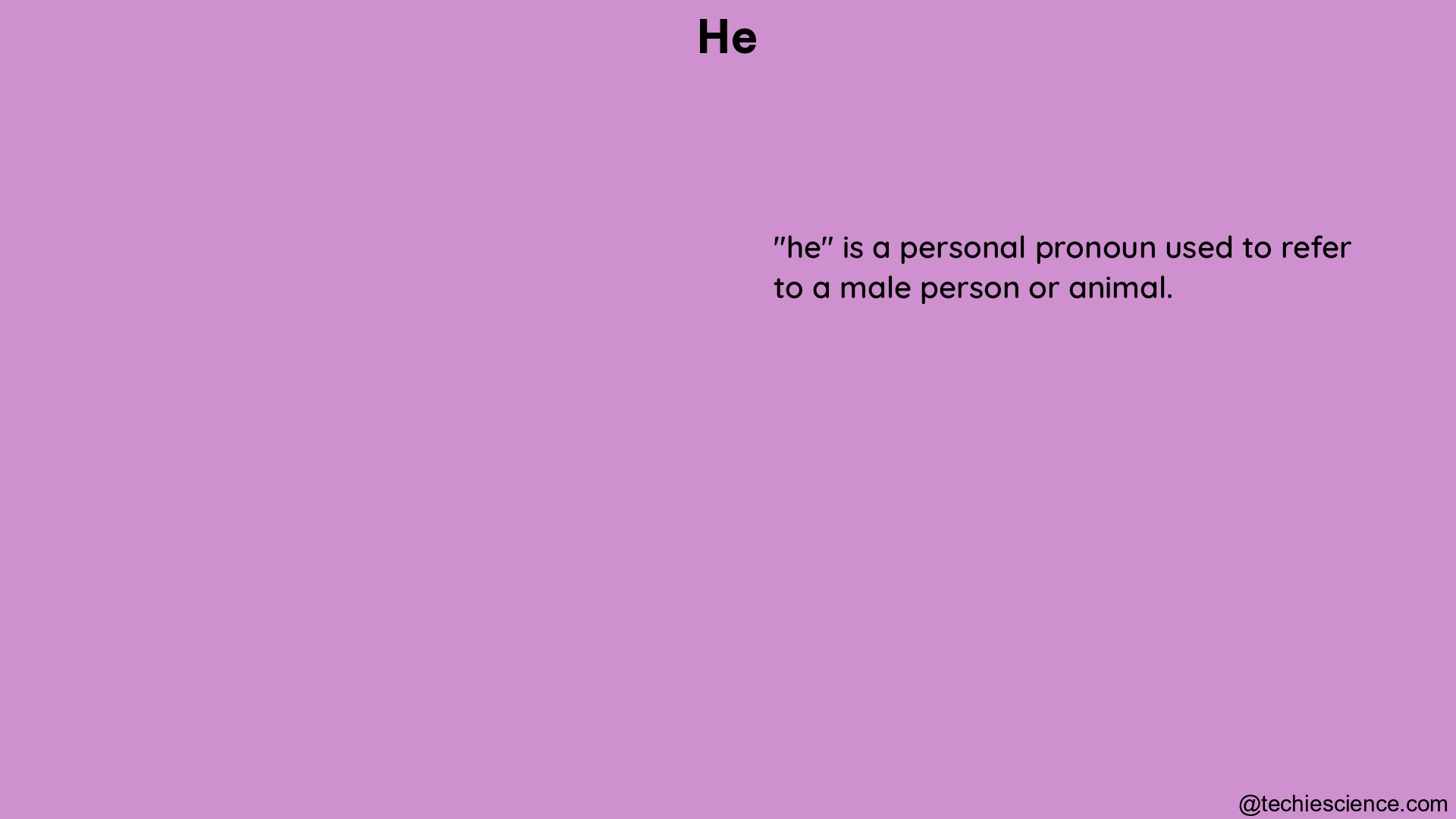The pronoun “he” is a fundamental part of the English language, used to refer to a male person or animal. As a third-person singular pronoun, “he” plays a crucial role in grammar, allowing us to communicate effectively and precisely. In this comprehensive guide, we will delve into the intricate details of the pronoun “he,” exploring its grammatical specifications, examples, theoretical explanations, and advanced usage.
Grammatical Specification
Nominative Case
In the nominative case, “he” is used as the subject of a sentence, indicating the person or animal performing the action. For example, “He is going to the store.” In this sentence, “he” is the subject, carrying out the action of going to the store.
Oblique Case
The oblique case refers to the use of “him” as the object of a verb or preposition. For instance, “I gave the book to him.” Here, “him” is the object of the preposition “to.”
Reflexive Case
The reflexive case utilizes the pronoun “himself” when the subject and object are the same. An example would be, “He washed himself.” In this case, “himself” indicates that the subject, “he,” is also the object of the action.
Possessive Case
In the possessive case, “his” is used to show ownership or belonging. For example, “That is his car.” The pronoun “his” demonstrates that the car belongs to the person referred to as “he.”
Examples

- Nominative Case:
-
“He is going to the store.” (Here, “he” is the subject performing the action.)
-
Oblique Case:
-
“I gave the book to him.” (Here, “him” is the object of the verb “gave”.)
-
Reflexive Case:
-
“He washed himself.” (Here, “himself” indicates that the subject and object are the same.)
-
Possessive Case:
- “That is his car.” (Here, “his” shows possession, indicating that the car belongs to him.)
Theoretical Explanation
The use of “he” as a pronoun is rooted in the concept of person and number in grammar. “He” is a third-person singular pronoun, meaning it refers to a single person or animal that is not the speaker (first person) or the listener (second person). The distinction between “he” and other pronouns like “she” and “they” is based on gender and number, with “he” specifically referring to a male person or animal.
Advanced Details
Generic Usage
Historically, “he” was used as both a masculine and a gender-neutral pronoun. However, since the mid-20th century, this generic usage has sometimes been considered sexist and limiting. To avoid this, writers and speakers may use “he or she,” alternate “he” and “she,” use the singular “they,” or rephrase sentences to use plural “they.”
Symbolic Usage
In certain contexts, “he” is used symbolically to refer to objects or entities that are traditionally considered masculine, such as certain stars or planets (e.g., the Sun, Mercury, Mars, Jupiter) or certain ships.
Grammatical Nuances
Subjective and Objective Forms
The subjective form of the pronoun “he” is used when the pronoun is the subject of a sentence, while the objective form “him” is used when the pronoun is the object of a verb or preposition.
| Subjective Form | Objective Form |
|---|---|
| He | Him |
Possessive Forms
The possessive forms of the pronoun “he” are “his” (used to indicate possession) and “himself” (used as a reflexive pronoun).
| Possessive Form | Reflexive Form |
|---|---|
| His | Himself |
Formal and Informal Usage
In formal writing and speech, the pronoun “he” is often used to refer to a person of unspecified gender. However, in more modern and inclusive language, the use of “they” as a gender-neutral singular pronoun has become increasingly common.
Contextual Considerations
Gender-Neutral Language
As mentioned earlier, the use of “he” as a generic pronoun has been criticized for being exclusive and potentially reinforcing gender biases. In recent years, there has been a push towards more gender-inclusive language, with writers and speakers exploring alternatives such as “they,” “he or she,” and gender-neutral phrasing.
Singular “They”
The use of the singular “they” pronoun has gained widespread acceptance as a gender-neutral alternative to “he.” This usage allows writers and speakers to refer to a person of unspecified gender without relying on the traditionally male-centric “he.”
Avoiding Assumptions
When using the pronoun “he,” it’s important to be mindful of making assumptions about a person’s gender. In professional and academic contexts, it’s generally best to use gender-neutral language or to explicitly ask for a person’s preferred pronouns.
Conclusion
The pronoun “he” is a fundamental part of the English language, with a rich history and nuanced usage. By understanding the grammatical specifications, examples, and advanced details surrounding “he,” we can communicate more effectively and respectfully. As language evolves, it’s essential to remain adaptable and inclusive in our use of pronouns, ensuring that our language reflects the diversity of the world around us.
References
- Merriam-Webster. (n.d.). He Definition & Meaning. Retrieved from https://www.merriam-webster.com/dictionary/he
- Dictionary.com. (n.d.). HE Definition & Meaning. Retrieved from https://www.dictionary.com/browse/he
- Wiktionary. (n.d.). he. Retrieved from https://en.wiktionary.org/wiki/he
- The Chicago Manual of Style. (2017). The Chicago Manual of Style (17th ed.). University of Chicago Press.
- Garner, B. A. (2016). Garner’s Modern English Usage (4th ed.). Oxford University Press.

The lambdageeks.com Core SME Team is a group of experienced subject matter experts from diverse scientific and technical fields including Physics, Chemistry, Technology,Electronics & Electrical Engineering, Automotive, Mechanical Engineering. Our team collaborates to create high-quality, well-researched articles on a wide range of science and technology topics for the lambdageeks.com website.
All Our Senior SME are having more than 7 Years of experience in the respective fields . They are either Working Industry Professionals or assocaited With different Universities. Refer Our Authors Page to get to know About our Core SMEs.